Article on Including Multilingual Support
- Introduction
- Adding Menus
- Example Details
- Add Menu Items
- Options - Frontend
- Notes on Downloads
- Change Language with Batch
- Layout Place holder
- Language Text Selectors
- Multi Language Associations
- Creating Associations
- Using Batch to create other language Categories and Downloads
- Other Text in jDownloads views
- Brief Note on Installing jDownloads Language Packs
- Appendix: Converting an Existing Site to Multilingual
Introduction
jDownloads supports Multilingual Categories and Downloads. Setting up a new or converting an existing site to be a Joomla! multilingual site is now relatively straight forward.
If you have not already done that there is an excellent Joomla! article https://www.joomlart.com/blog/how-to-create-a-multilingual-website-in-joomla-4-step-by-step-tutorial (opens in a separate window/tab).that takes you through the entire process of setting up a new multilingual site from scratch in a step by step manner. A more recent update is https://www.joomlashine.com/blog/create-multilingual-joomla-site.html (opens in a separate window/tab).
If you have not already done that there is an excellent Joomla! article https://www.joomlart.com/blog/how-to-create-a-multilingual-website-in-joomla-4-step-by-step-tutorial (opens in a separate window/tab).that takes you through the entire process of setting up a new multilingual site from scratch in a step by step manner. A more recent update is https://www.joomlashine.com/blog/create-multilingual-joomla-site.html (opens in a separate window/tab).
It is important that you set up the Joomla! requirements including the Languages. There are multiple steps in setting up the Joomla! part.
- Installing new languages
- Enable System Language Plugins
- Create Multilingual content (articles and article categories)
- Multilingual Menus for each language
- Set default Home page for each menu
- Display on Front End
- Make Associations
- Set Language Switcher Module
If you already have an existing site that you need to convert to multilingual then there are additional notes in the Appendix below where some stages in the process are outlined. Also you may find this article on converting a unilingual site to a multilingual site (opens in a separate window/tab)helpful. Additional assistance might be to create a simple multilingual site in a test environment to see what it looks like in the backend to act as a guide.
The purpose of this article is to note the jDownloads specifics and to illustrate the results.
It is assumed in this article that the Joomla! language translations are already installed.
Language packs for extensions are installed just like any other extension, they do not use the Install Language as that is only used for Joomla! languages.
Please see the article on installing Language packs for jDownloads (opens in a new tab/window) or the brief note in Appendix.
This uses Extensions - Language(s) - Installed. This gets you to a page showing which Joomla! languages are installed, and on the control bar there is an button that will allow you to select the Joomla! language. This process is also decribed in the Setup a Multilingual site link above.
button that will allow you to select the Joomla! language. This process is also decribed in the Setup a Multilingual site link above.
So once that is done the next step is to install the relevant jDownload languages, but note jDownloads is distributed with English and German already installed.
Language packs for extensions are installed just like any other extension, they do not use the Install Language as that is only used for Joomla! languages.
Please see the article on installing Language packs for jDownloads (opens in a new tab/window) or the brief note in Appendix.
This uses Extensions - Language(s) - Installed. This gets you to a page showing which Joomla! languages are installed, and on the control bar there is an
So once that is done the next step is to install the relevant jDownload languages, but note jDownloads is distributed with English and German already installed.
In a multilingual site it is preferable that all content items, which includes jDownloads Categories and Downloads, should have a specific language set. Setting the language of a content item to 'All' is however appropriate in some circumstances, a particular example might be the Uncategorised caegory which is often used for Downloads awaiting allocation to another category. In jDowloads the language options for Categories and Downloads are in entries Category Language and Download Language respectively.
There are some instances where text is set in the jDownloads backend so to make this language sensitive jDownloads supports the language 'plugins'
like {en-GB}some text{/en-GB}. These are described further below in the section Other Text.
There are some instances where text is set in the jDownloads backend so to make this language sensitive jDownloads supports the language 'plugins'
like {en-GB}some text{/en-GB}. These are described further below in the section Other Text.
In principle if a site supports say three languages then there will be three sets of categories and three sets of Downloads.
This could also mean that there would be three sets of downloadable files which could be a significant space issue.
Note however that jDownloads also supports Downloads where the downloadable file is actually in another Download.
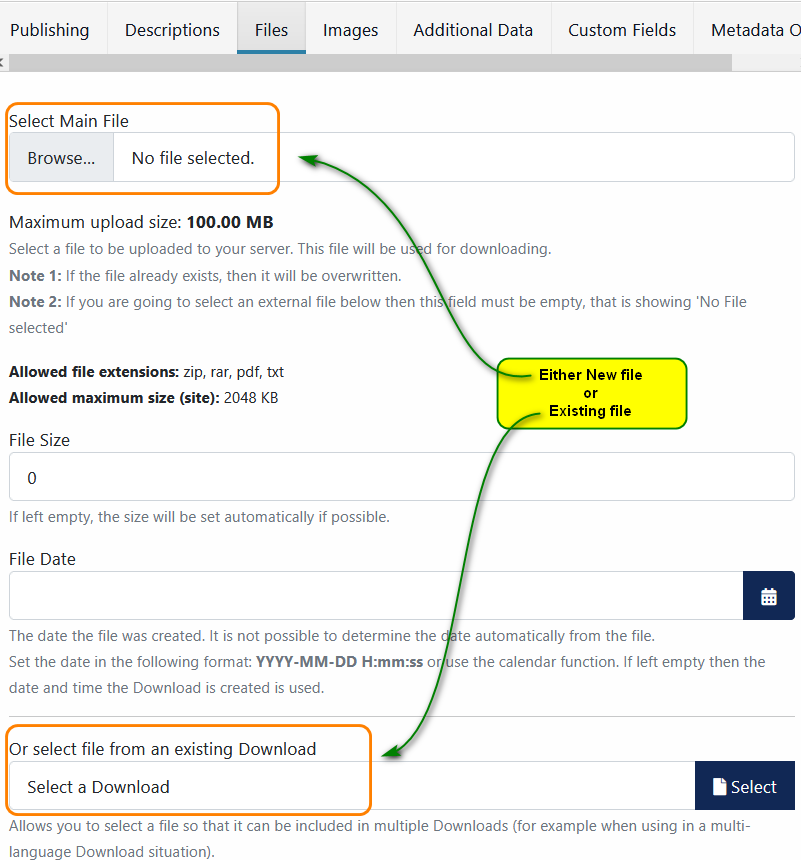
In the jD 3.9 and above series the User Groups settings have been enhanced to allow 'Or from another Download' to be used in the front end.
See the article on User Groups Settings for more details.
See the article on User Groups Settings for more details.
Support for RTL languages
Support for RTL languages is available in jDownloads 3.9.7.x and higher
An example is shown opposite in Arabic Unitag.
Please note that the translations team have not completed their work yet.

Please note that the translations team have not completed their work yet.

An additional CSS file, jdownloads_fe_rtl.css, is automatically loaded when when an RTL language is detected.
This additional CSS file may be exported, imported or edited in the same way as the other CSS files.
This additional CSS file may be exported, imported or edited in the same way as the other CSS files.
Adding Menus
When setting up a multilingual site a key stage is to setup a menu for each language and then later, after creating content, to add relevant menu items.
The image opposite illustrates the Menus set up in the example described below.
It has a Main Menu and 4 'language' based menus named Main Menu(AR), Main Menu(DE), Main Menu(EN) and Main Menu(FR). These will be used to add relevant menu items. The 'Linked Modules' are created automatically.

Example Details
In this article a multilingual site with the four languages Arabic, English, French and German is setup. To clarify the language used each article, category or Download title ends with (ar), (de), (en) or (fr) to indicate its language setting.
Assigning a language to jDownloads Categories and Downloads are by using the pull-down in the relevant option as indicated opposite.
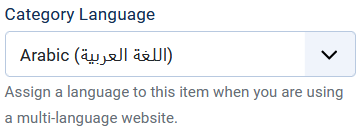
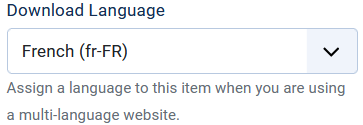


Articles and Article Categories use option 

The next step was to create an Article category and an Article for each language. Similarly a top level jDowloads Category, each with two subcategories, were created for each language. Each sub subcategory was populated with four downloads.
In the lists below 'xx' is either -ar-, -de-, -en- or -fr-. There are:
In the lists below 'xx' is either -ar-, -de-, -en- or -fr-. There are:
- 4 article categories entitled as 'Article Cat-xx'
- 4 articles, one per article category, entitled as 'Test article-xx'
- 4 top level jDownloads Categories entitled 'Test Dir-xx'
- 8 subcategories, two per language, named as 'pdf files-xx' and 'zip files-xx'
- each sub category then had 4 downloads each, again with the title ending in -xx, giving a total of 32 Downloads.
NOTE the -xx suffixes are only here for explanation purposes. They are not required in an active site.
In addition to the above there are several 'All' language jDownloads Categories , subcategories and Downloads in the example site.
In addition to the above there are several 'All' language jDownloads Categories , subcategories and Downloads in the example site.
The Article Categories, the articles themselves, the relevant jDownloads Catgories and subcategories, and the relevant Downloads were all associated with their counterparts in the other languages as described later in this article.
As an example the Downloads specifically denoted for the English language are shown below with their associations.
As an example the Downloads specifically denoted for the English language are shown below with their associations.
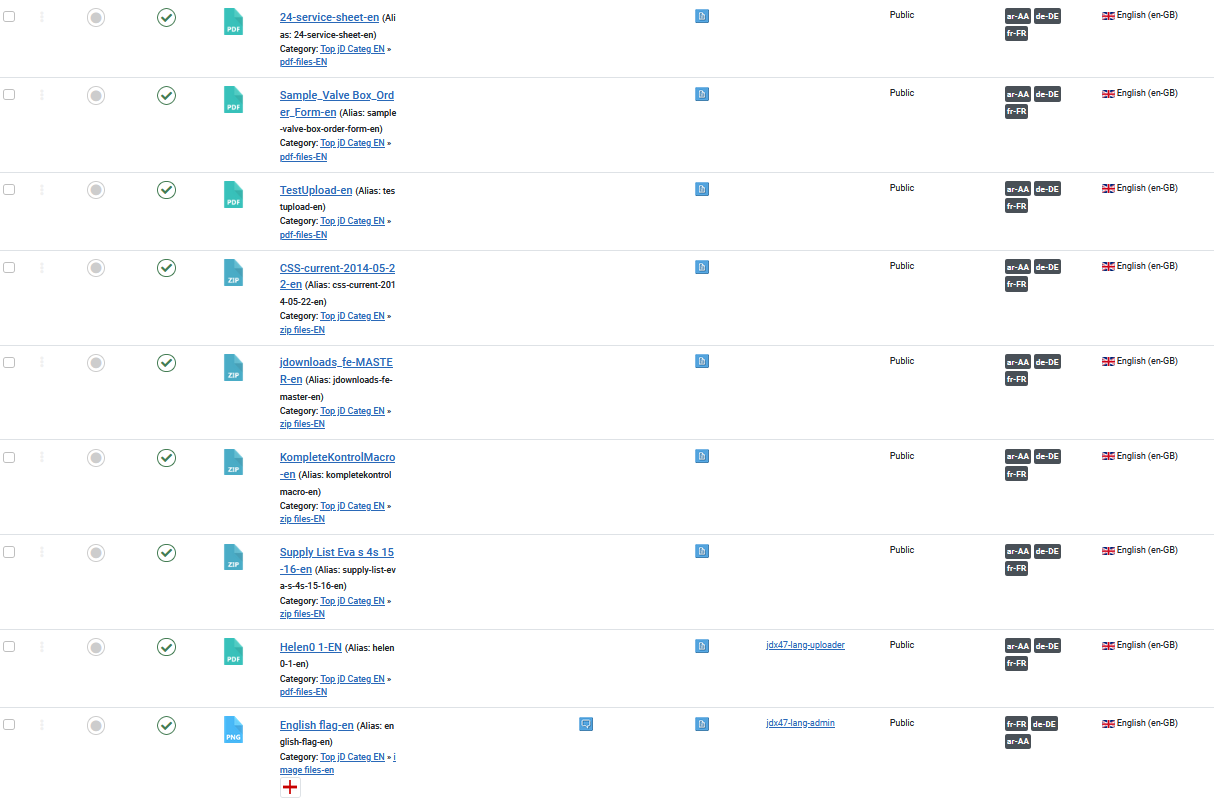
Add Menu Items
Now that some content has been created we can add menu items to the Menus created earlier. The example menu item titles are shown in English together with an -xx in the text to denote the language.
When setting up menus it is helpful if you also look at article Menus -Overview and Details (opens in a new window/tab).
When setting up menus it is helpful if you also look at article Menus -Overview and Details (opens in a new window/tab).
The image below shows the results of setting up a main English language menu with one language related article menu items and six jDownloads menu items.
Note that all that each menu item has been 'associated' with its counterpart in other languages as described later.
Note that all that each menu item has been 'associated' with its counterpart in other languages as described later.
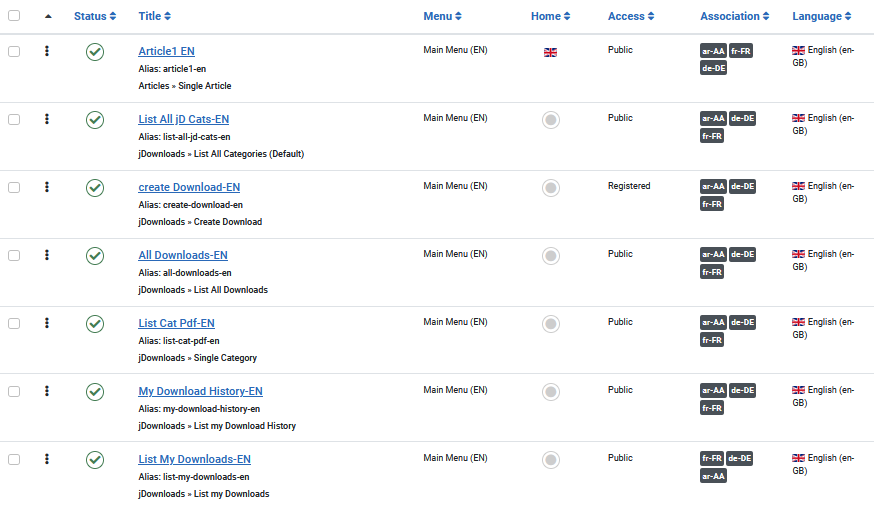
Click on Home for one of the menu items to denote it as the 'Home' item. It will show the relevant language flag to denote it as the Home item, it does not matter which menu item is used.
Add List All Cats
There is one final step that is very important in the menu item creation phase.
Create a jD 'List All Categories' Menu item in the  .
.
Note this has a language setting 'All' and it is usually set as a 'Hidden' menu item. (see below for details)
It is used by jDownloads when constructing links. It is not used by users!
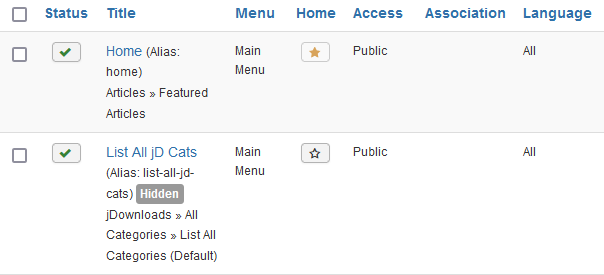
Note this has a language setting 'All' and it is usually set as a 'Hidden' menu item. (see below for details)
It is used by jDownloads when constructing links. It is not used by users!

Hiding a Menu Item
To make a menu item 'hidden', click on the menu item in order to edit it as shown opposite.

Then select the 'Link Type' tab and set option 'Display in Menu' to No.
After clicking the

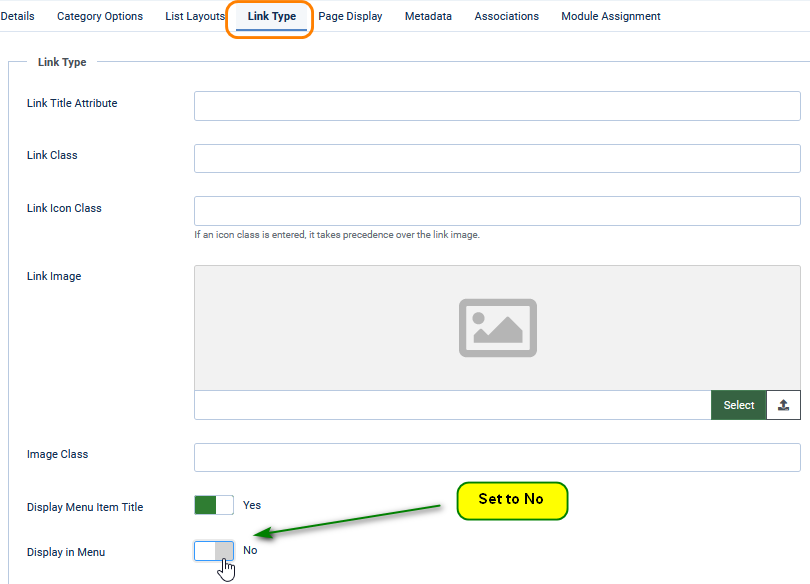
Options - Frontend
There are only two jDownloads  settings relating to a multilingual setup. These are in the Frontend tab and are illustrated opposite.
settings relating to a multilingual setup. These are in the Frontend tab and are illustrated opposite.
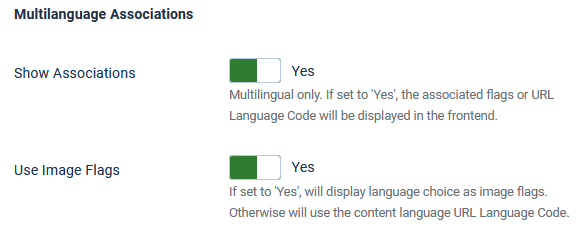

If 'Show Associations' is set to 'Yes', the associated flags or URL Language Code will be displayed in the frontend.
The 'Use Image Flags' option also appears allowing choice of showing either the flags of associated items or the content language code.
Notes on Downloads
Before discussing the multilingual associations, it is useful here to first recall what makes up a Download. A Download obviously has a title, an alias, permissions, access level, user access, a publication status, a language attribute and it is located in a category. Optionally it may also have descriptions, symbols, images, previews, price, licence and many other items. All of these are stored in the database. Usually, but not always, a Download includes a downloadable file. The downloadable file is not in the database. In most cases it is stored on your site in a sub-directory of the jDownloads directory, but it may also be stored on an external site see downloads on external site (opens in new window/tab) for more information
It is worth noting that the title of a Download and the name of the downloadable file are not the same item and, in principle, are not related; they could be totally different.
Actually a Download has two language related items. One, which is the multilingual item, is called the 'Download Language' (in some places it might just be 'Language'). The other falls into the class of additional information and is called the 'Language for the downloadable file'. This does not necessarily relate to anything multilingual but could refer, for example, to the programming language of the file. It is the Download Language that is used with Associations. Usually the structure of a Download is the same in each language.
The exact content will obviously change, most obviously the Title of the Download will be in a different language. Items such as the symbol, the licence, the creator and so on will often be the same for all the associated Downloads. Sometimes the only difference between a Download in one language and its associated Download in another language might be the title, alias and the description.
Clearly a Download will be created in one language initially. To ensure that the corresponding Downloads in the other languages are similarly structured then using the Multilingual Create/Edit method may be more useful.
It is worth noting that the title of a Download and the name of the downloadable file are not the same item and, in principle, are not related; they could be totally different.
Actually a Download has two language related items. One, which is the multilingual item, is called the 'Download Language' (in some places it might just be 'Language'). The other falls into the class of additional information and is called the 'Language for the downloadable file'. This does not necessarily relate to anything multilingual but could refer, for example, to the programming language of the file. It is the Download Language that is used with Associations. Usually the structure of a Download is the same in each language.
The exact content will obviously change, most obviously the Title of the Download will be in a different language. Items such as the symbol, the licence, the creator and so on will often be the same for all the associated Downloads. Sometimes the only difference between a Download in one language and its associated Download in another language might be the title, alias and the description.
Clearly a Download will be created in one language initially. To ensure that the corresponding Downloads in the other languages are similarly structured then using the Multilingual Create/Edit method may be more useful.
Change Language with Batch
Note the Batch facility is also very useful for changing the language of the Categories and all the Downloads in a category and its subcategories. It may be used to just change the language as well as making a copy of one or more Downloads. There is also a batch process to change the language of a License.
In the example opposite there are three French JD Categories but the Language setting is All.
So select all of them and then click on the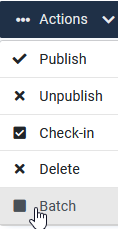 Batch button in the Actions pulldown.
Batch button in the Actions pulldown.
This brings up the Batch facility so use the Set Language pull down to select the target language.
Having set the language ensure that No is selected in the 'Do you want to move' - No is the default.
Then click on the button.
button.
The result is shown opposite with all the relevant categories set to French.


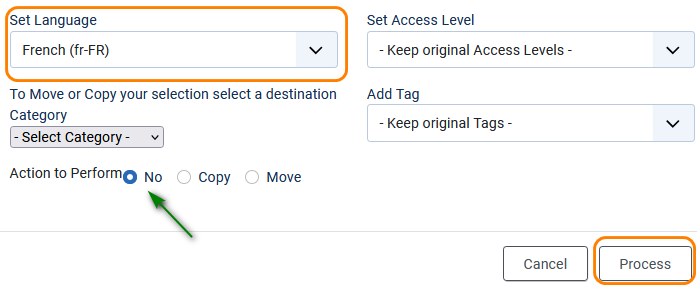

So select all of them and then click on the
This brings up the Batch facility so use the Set Language pull down to select the target language.
Having set the language ensure that No is selected in the 'Do you want to move' - No is the default.
Then click on the
The result is shown opposite with all the relevant categories set to French.




The same batch mechanism may also be used for the Downloads. Here it is simple to use the Search tool to select the relevant top level category as that will also list all the Downloads in the sub categories so you can select them all.
For more information see batch processing (opens in a new widow/tab).
For more information see batch processing (opens in a new widow/tab).
Layout Place holder
The jDownloads Download and Download Details layouts have a placeholder {show_association} which generates a text such as shown opposite.
If, for example, you click on the French flag,
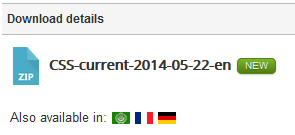
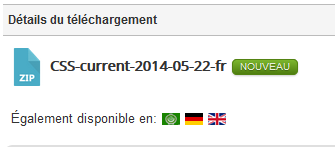
Language Text Selectors
In many text strings you may use the short code text selectors as illustrated below. This example is taken from Options - E-Mails tab. It appears after setting Activate E-Mail to Yes. The {de-DE} section was added.

Multi Language Associations
The key to a successful multilingual site are Associations. When constructing such a site then each language has a 'language specific version' of each Category and each Download. The principle aspect of an Association is that it lets the system know items are 'joined' so that if you switch between languages then the relevant associated item is shown.
Please note that you may also create multilingual Licenses.
In this article a four language site with Arabic, English, French and German items is used for demonstration examples. So there will be "flags" like . which will appear at the top right of the view for a left to right language, and at the top left for a rght to left language. Clicking on one of them will switch the entire site to the selected language.
. which will appear at the top right of the view for a left to right language, and at the top left for a rght to left language. Clicking on one of them will switch the entire site to the selected language.
As noted in the Options above the flags, or language codes, may also appear in the Download. Actually when showing in say English then only the flags for the other languages are shown: . Clicking on one of these flags will change to the associated Download Details view.
. Clicking on one of these flags will change to the associated Download Details view.
Please note that you may also create multilingual Licenses.
In this article a four language site with Arabic, English, French and German items is used for demonstration examples. So there will be "flags" like
As noted in the Options above the flags, or language codes, may also appear in the Download. Actually when showing in say English then only the flags for the other languages are shown:
Creating Associations
In the following we show two methods of associating Categories and associating Downloads.
One method is to use the Control Panel Categories or Downloads
or Downloads  entries as appropriate.
entries as appropriate.
The other method is to use the Multilingual Associations entry.
entry.
In this article to hopefully make thing clearer, Categories have titles of the style "Test Cat-XX" where the XX indicates the language of the category. Thus the top level categories are Test Cat-AR, Test Cat-EN, Test Cat-FR and Test Cat-DE. Download titles have a similar convention.
Note: This is not a requirement, it is just an attempt to simplify the explanation!
One method is to use the Control Panel Categories
The other method is to use the Multilingual Associations
In this article to hopefully make thing clearer, Categories have titles of the style "Test Cat-XX" where the XX indicates the language of the category. Thus the top level categories are Test Cat-AR, Test Cat-EN, Test Cat-FR and Test Cat-DE. Download titles have a similar convention.
Note: This is not a requirement, it is just an attempt to simplify the explanation!
Each of these top level categories has two subcategories, one called 'pdf files-XX' and the other called 'zip files-XX'.
The pdf-files-en sub categories are illustrated opposite.
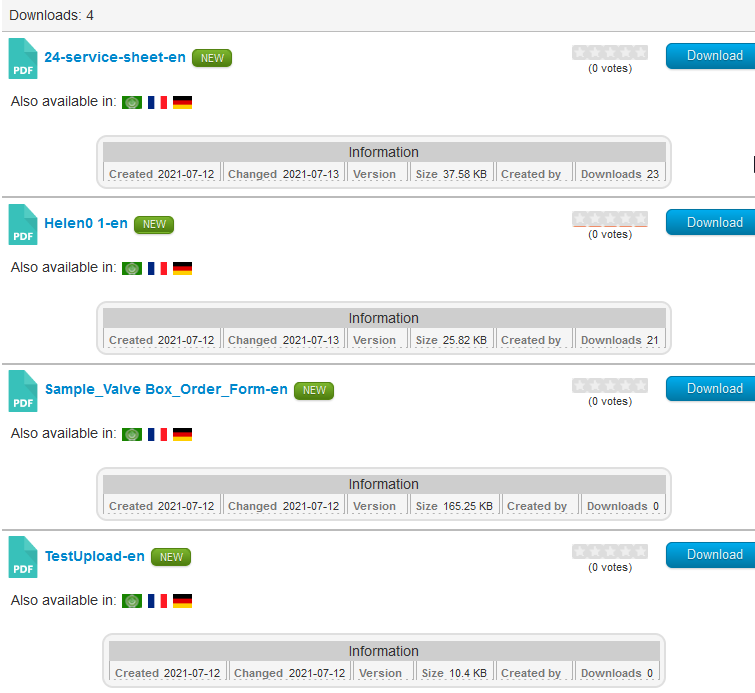
Using  or
or 
Selecting
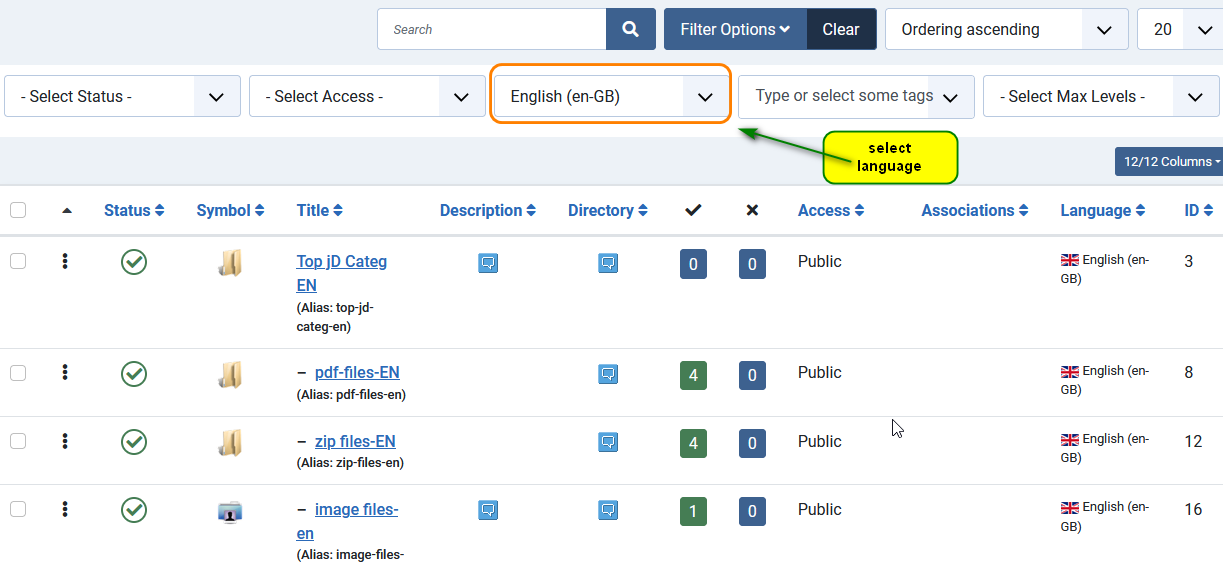
Clicking on the name of one of the categories, say 'pdf files-EN' for example, and then selecting the Associations tab shows the other languages.
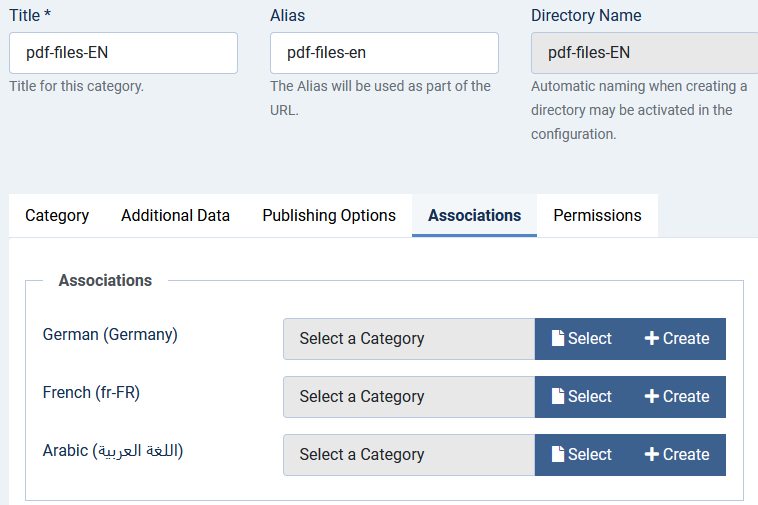
After clicking on the
Next click on the name of the category that is to be "associated" with the original category, in this example 'pdf files-DE'.

This will then go back to the Associations tab which now looks as shown on the right.

After repeating for all the languages then click on Save & Close which returns to the list of categories.

This shows that the associations have been set. Also it is sometimes useful to choose a different Category symbol for each language.
If you hover the mouse over an association it shows the name of the associated item.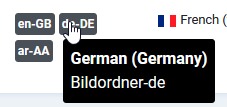

The sequence for associating Downloads is the same except of course it starts with  in the control panel.
in the control panel.
Using 
In many instances it is much simpler to use the Multilingual Association entry in the Control Panel as it also offers Create/Edit facilities
Clicking on the  button will show the current status of the Associations for either Categories or Downloads in the selected language.
button will show the current status of the Associations for either Categories or Downloads in the selected language.
In the image opposite all the Associations for the categories for each the languages were established using the first method as described above.
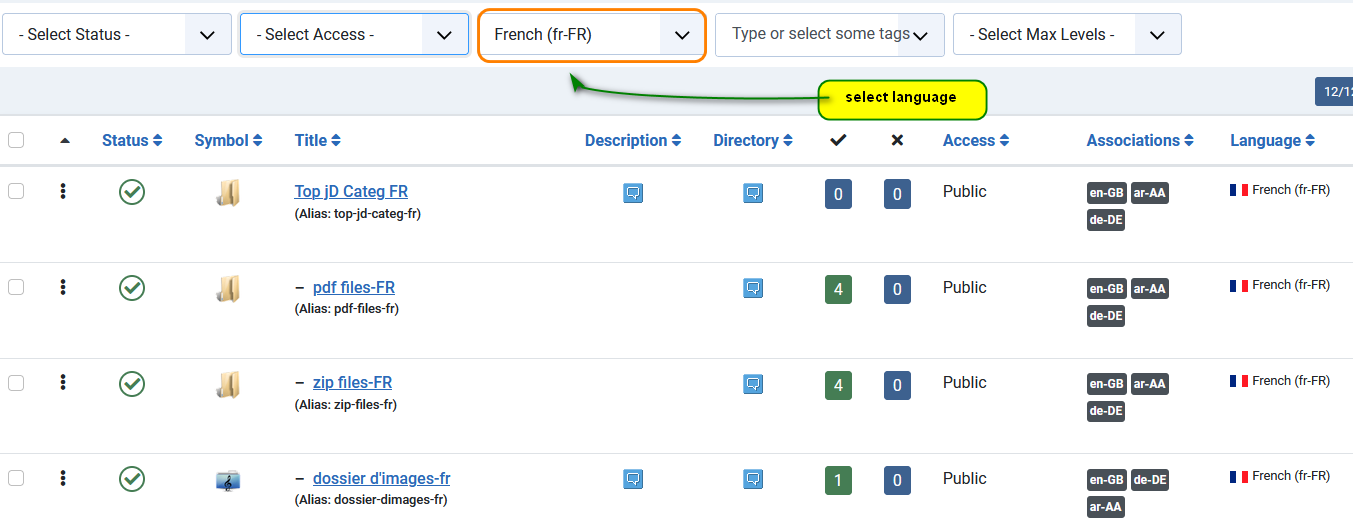
In the image opposite all the Associations for the categories for each the languages were established using the first method as described above.

Using the pull downs at the top left select Downloads and the language.
Note that no Downloads have Associations established yet.
Clicking on a Download title opens the Multilingual editing screen as shown below.
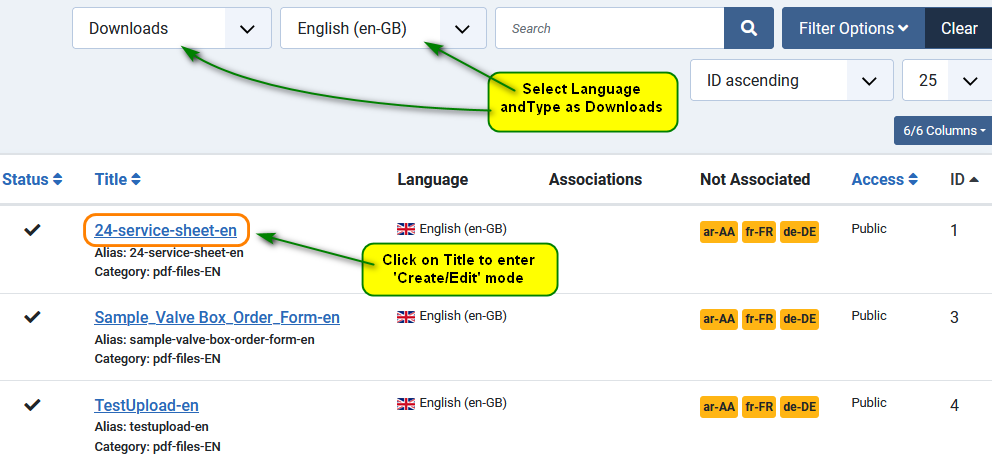
Initially the righthand side of the screen will be empty.
First use the Language pulldown

At this time there is no associated Download so the 'Create a Download' view is shown.
If a Download had already been associated in the selected language then the 'Edit' view would be shown.
But note the Select Target button, so click on it.
But note the
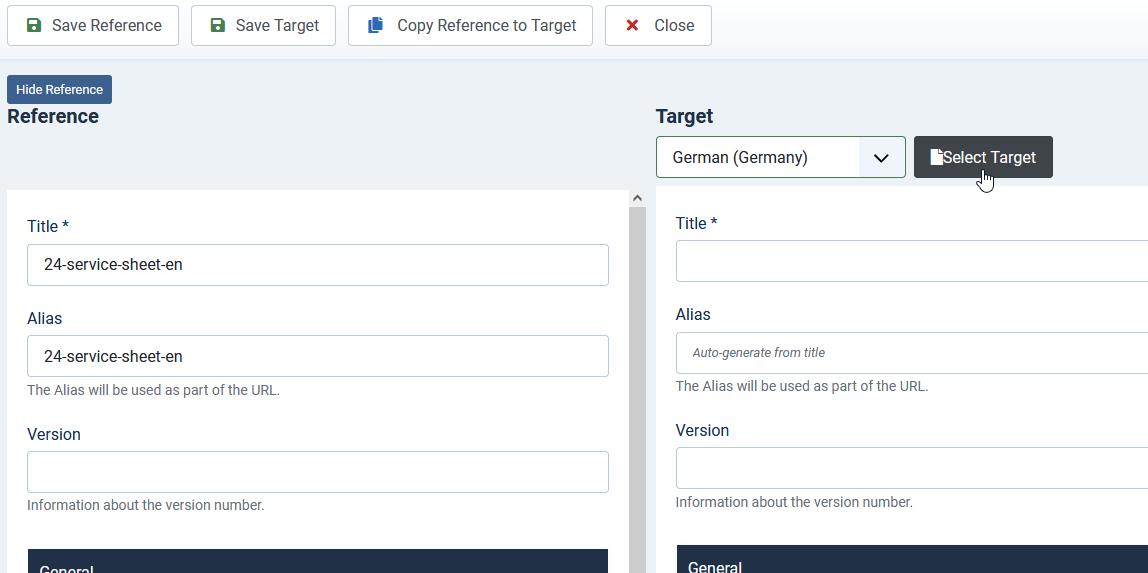
This gives a list of all the Downloads in the specified language.
Click on the title of the Download that is to become associated with the Reference Download.
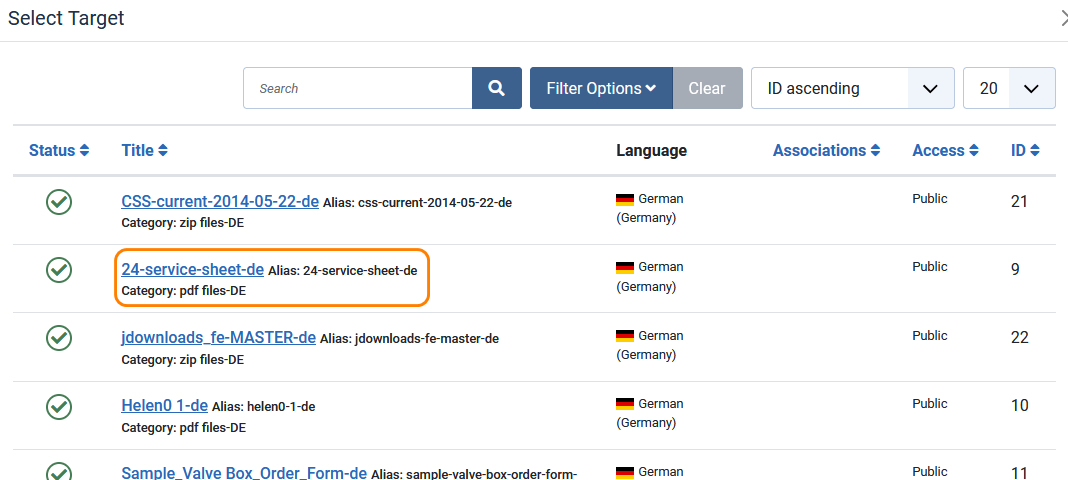
Click on the title of the Download that is to become associated with the Reference Download.

This returns to the Reference and Target 'double page' view.
Ensure you click on the
If you do not Save the Target then all the effort is lost!
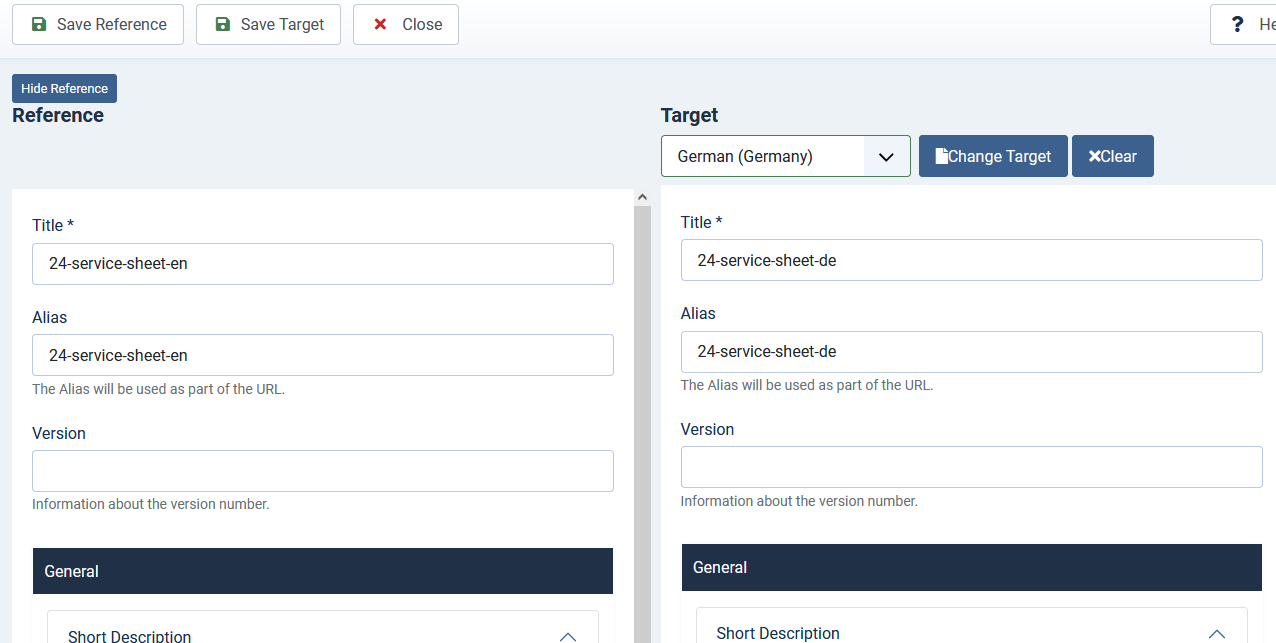
After closing the 'double page', the Multilingual Associations view is shown. This now shows that, in this example, the English and German Downloads have been 'associated'.


Using Batch to create other language Categories and Downloads
The Downloads Batch facility may be used in three ways:
- Move multiple Downloads from the present Category to another Category and set the language, access or tags of the 'moved' Downloads ;
- Copy multiple Downloads from the present Category to another Category and set the language, access or tags of the copied Downloads;
- Just set the language, access or tags of multiple Downloads
So having made one or more Downloads in one language then it is the Copy function that is most useful to get them copied over to the associated category.
- When you COPY a Download only the Download is duplicated; no downloadable file is duplicated.
- If COPY is selected then any other selected actions are applied to the copied item but not to the original item.
- Preview Files and Images used in Downloads are held in a 'central' location with database entries indicating their location so those links are also copied.
Existing Multilingual Sites
There is a  function in both Categories and Downloads.
function in both Categories and Downloads.
From the Downloads screen in the backend select (tick) the Downloads that you wish to copy to another Category then click on the Batch button.
This will bring up the batch function window. Set the required language and target category and click Process.
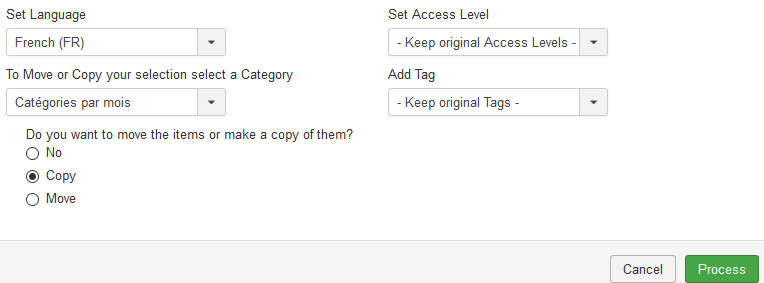
This will bring up the batch function window. Set the required language and target category and click Process.

In the example this was repeated for the German language.
The example Downloads were renamed to match the language and the Associations set up as described above.
Remember that the downloadable files themselves will not have been copied.
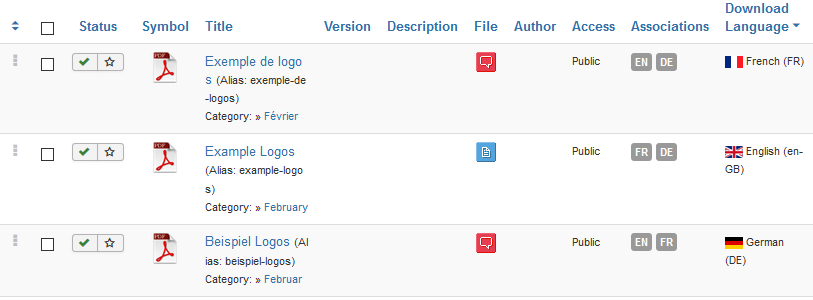
Remember that the downloadable files themselves will not have been copied.

So if you look at the Downloads listing, such as the one shown opposite, then you will find that the 'copied ' Downloads have no downloadable file as indicated by the red symbol .
.
If you click on the name of one of the files and select the Files Data tab you may either select a new file or select a file from another Download. This facility is available in the Front End as well as the Backend.
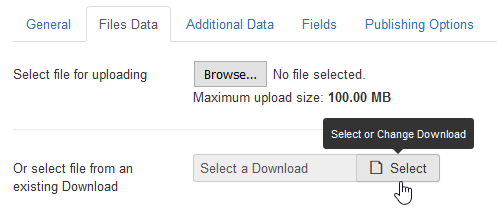
In this instance using a file from another Download was selected. The Other Download selected was of course 'Existing Logos' as the downloadable file is just a pdf with a set of car logo images.
After being selected and returning to the list of Downloads the result is shown opposite.
The file icon is now orange in colour to denote the downloadable file is in another Download.
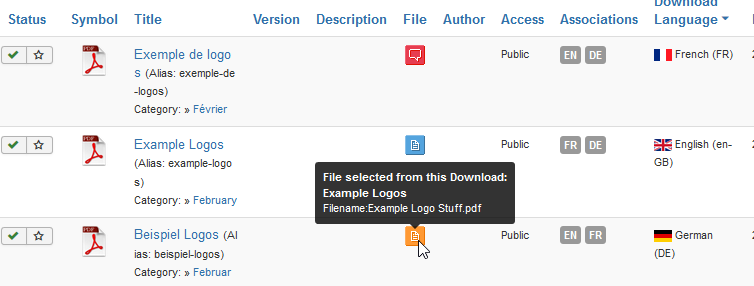
Hovering the mouse over the orange symbol,  , gives the Category and file name of the actual downloadable file. Obviously this is repeated for the other language.
, gives the Category and file name of the actual downloadable file. Obviously this is repeated for the other language.
Converting to Multilingual
If you have an existing site which you need to convert to a multilingual site then after following the multilingual setup you will no doubt be left with many jD categories and Downloads that have the Language set to All. With more than say a dozen entries, it would be extremely time consuming to go through each and every category and Download to change to what one might refer to as the 'original' language.
Using the Batch facilities simplifies the whole language changeover process. The site can be up and running with an explanatory note about the changeover being carried out. The translations and adding downloadable files are readily carried out from the front end.
Using the Batch facilities simplifies the whole language changeover process. The site can be up and running with an explanatory note about the changeover being carried out. The translations and adding downloadable files are readily carried out from the front end.
Other Text in jDownloads views
There are various places in the Options where ancillary text may be used. For example in Options - Front End tab there are setting for 'Component Description' and 'Footer Text'. If you use AUP in the Specials tab then the message to the user would benefit from being made language sensitive. Another possibility is making the email subject language sensitive in the E-Mail tab.
In User Groups Settings - Limits tab there are multiple places where making the message to the user language sensitive would be most useful. Also in User Groups settings -Group Settings tab the Waiting Time Message would be better as language sensitive.
In User Groups Settings - Limits tab there are multiple places where making the message to the user language sensitive would be most useful. Also in User Groups settings -Group Settings tab the Waiting Time Message would be better as language sensitive.
To make these items Language sensitive jDownloads supports language 'plugin' tags such as {en-GB}...{/en-GB} for English.
To determine the language tag for a language go to Extension Manager -Language(s). This will show the list of languages installed in Joomla and the relevant language tag.
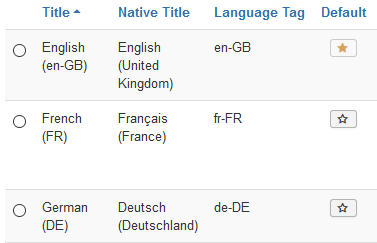
You also need to install the corresponding jDownloads language pack as described below. Installing a language pack for a component does NOT use the Extension Manager - Languages.
As an example let us modify the Component Description in Options- Front End tab so that it looks as shown opposite. Note that the text may also contain HTML. 

The result for each language is shown opposite



Brief Note on Installing jDownloads Language Packs
To install another language in jDownloads use the regular Extension Manager - Install as if you were installing any extension.
Do NOT use the Install Languages tab. Now browse for the file then Upload & Install
For a more detailed explanation see Install a jDownloads Language Pack. (opens in a new window/tab)
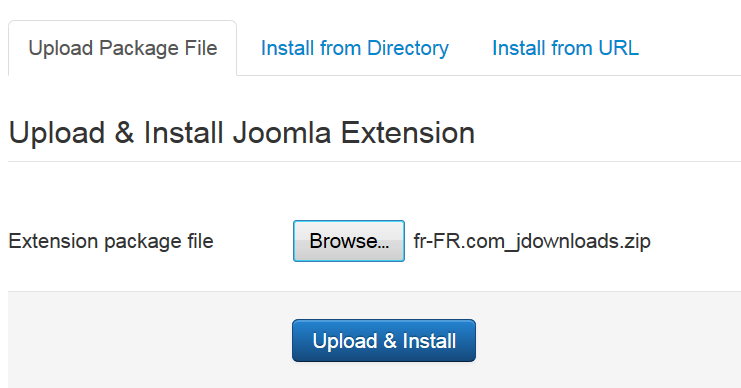
Do NOT use the Install Languages tab. Now browse for the file then Upload & Install
For a more detailed explanation see Install a jDownloads Language Pack. (opens in a new window/tab)

Note It is essential that the normal Joomla! language package has already been installed first.
That is in this example the French language for Joomla! must already be installed. No warning is given if it has not been installed!
That is in this example the French language for Joomla! must already be installed. No warning is given if it has not been installed!
Typically you will then see a message such as opposite. You now have the jDownloads Language installed.

Appendix: Converting an Existing Site to Multilingual
These notes are based on a response by nizz0k in StackExchange
The process will require a number of steps. It is much less tedious to plan a multi-language site from the beginning, than to implement another language later. I recommend getting translations for your content in advance. These are the steps I went through to get satisfactory results.
- Install the desired Joomla! languages through Extensions -> Languages.
- Configure and add your Content Languages in the Languages Menu.
- Enable the Language Filter Plugin. Optionally add and enable the Language Code module for better SEO.
- Create Language Content categories and recreate your existing categories for each language.
- Rebuild your menus. This is probably the most involved step because you will have to recreate your Main Menu in your "Main" language and then rebuild those menus for the additional language(s) you want to add. I found that using "Saves as a Copy" was really helpful in duplicating the pages. Remember to assign menu specific home pages and associating each page with its translation. To finalize the process you will have to add modules to each menu in the menu manager.
- Translate/Add/Remap your content. You will need translations of every piece of content you want to display. Then you need to add the content, label it with the appropriate language, and associate it with the "Main language" versions. This will include creating new Language categories and subcategories. I also had to save copies and re-label a number of my modules to maintain language consistency. This also meant applying translations to a number of Custom HTML modules, and a few of my own modules.
- Add the Language Switcher Module.
- Iteratively check the site for consistency. As an FYI, any pages that don't show up in the menu it is probablybecause they not categorized in the correct language.
Colin Mercer June 2019, Modified July 2021,June 2022, May 2023
 ownloads Documentation Centre!
ownloads Documentation Centre!